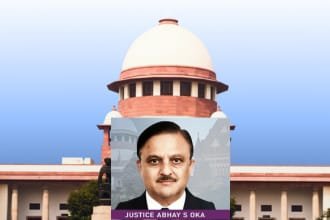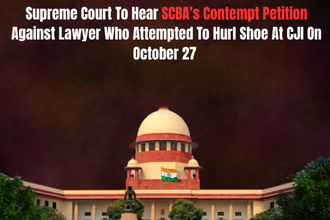In a significant interim ruling, the Supreme Court of India has stayed the Jammu & Kashmir High Court’s directive that prohibited toll collection on poorly maintained highways. The High Court had earlier ordered an 80% reduction in toll rates at the Lakhanpur and Bann Toll Plazas on National Highway 44, citing the substandard condition of the road. However, the apex court has now allowed the National Highways Authority of India (NHAI) to continue collecting toll at 75% of the standard rate, in accordance with Rule 4(9) of the National Highways Fee (Determination of Rates and Collection) Rules, 2008.
This order, passed in the case titled National Highways Authority of India v. Sugandha Sawhney & Ors., has important implications for infrastructure regulation, user rights, and toll policy enforcement across India.
Background of the Case
The controversy began when commuters raised serious concerns about the deteriorated condition of NH-44, particularly in the stretch between Lakhanpur and Bann in Jammu & Kashmir. Alleging pothole-ridden roads, traffic congestion, and prolonged construction delays, the petitioners moved the J&K High Court seeking relief from paying tolls at full rates for a road that was not motorable by national standards.
In response, the J&K High Court passed an order slashing the toll charges by 80%, effectively directing toll plaza operators to charge only 20% of the usual toll fee. The order emphasized that it was unjust to burden commuters with full toll charges for infrastructure that was incomplete or unsafe.
NHAI’s Challenge Before the Supreme Court
Aggrieved by the High Court’s directive, the NHAI filed a Special Leave Petition (SLP) before the Supreme Court, contending that the order was in contravention of the statutory framework governing toll collection. NHAI argued that Rule 4(9) of the National Highways Fee Rules already provides a mechanism to reduce toll rates in cases of highway deterioration or lane closures due to maintenance or construction.
As per Rule 4(9), if the road condition is suboptimal, the toll can be reduced to 75% of the notified rate. NHAI maintained that this rule had been complied with, and the toll was being collected accordingly.
Supreme Court’s Interim Order
A Bench of the Supreme Court, while hearing the matter, observed that the High Court’s blanket reduction of toll charges by 80% went beyond the scope of judicial discretion when a statutory mechanism already exists. The Bench, thus, stayed the High Court’s order, and permitted NHAI to continue collecting 75% of the standard toll in accordance with Rule 4(9).
The apex court emphasized that judicial intervention in toll policy must be balanced with statutory provisions, and until the final adjudication of the matter, interim measures must not disrupt public infrastructure funding models.
What is Rule 4(9) of the National Highways Fee Rules?
Rule 4(9) states that if the stretch of a national highway or part thereof is under construction, maintenance, or repair and does not provide the minimum level of service as prescribed, the toll fee shall be reduced to 75% of the applicable rate until the deficiencies are rectified.
This provision aims to ensure fairness to road users without compromising toll revenue necessary for infrastructure upkeep.
Legal and Policy Significance
The Supreme Court’s stay order carries multiple layers of legal and policy significance:
- Judicial Restraint in Economic Regulations: The ruling reiterates the principle that courts must exercise restraint in economic matters, especially where detailed statutory mechanisms exist.
- Recognition of User Rights: The case also highlights the growing awareness and assertion of commuter rights. With increasing instances of substandard national highways, public scrutiny of toll policies has intensified.
- Clarity on Toll Reductions: The decision clarifies that blanket toll waivers or arbitrary reductions by courts are not legally tenable when specific statutory rules govern such contingencies.
- Infrastructure Financing Stability: For NHAI and other concessionaires, the ruling provides relief by preserving the toll revenue stream, albeit at a reduced rate, thereby safeguarding long-term project viability.
Public Reaction and Commuter Concerns
While the Supreme Court’s intervention ensures compliance with the law, commuters have expressed dissatisfaction over continuing to pay toll on damaged or incomplete roads. Many believe that even the 75% rate is too high when daily travel becomes hazardous, slow, and economically burdensome.
Citizen advocacy groups have demanded that toll collection be suspended altogether on roads that fail basic safety standards. They argue that the existing rules favor contractors and NHAI while not adequately protecting consumer rights.
Broader Implications for Highway Management in India
This case is part of a larger debate on road infrastructure quality versus user fees. As India rapidly expands its highway network, questions about accountability, maintenance standards, and fair toll pricing are becoming more pressing.
Experts argue that NHAI and the Ministry of Road Transport and Highways (MoRTH) must:
- Increase transparency about highway construction timelines and quality standards.
- Enforce penalties on contractors failing to meet road maintenance benchmarks.
- Create grievance redressal mechanisms for commuters affected by poor road conditions.
- Consider a tiered toll system based on real-time road quality assessments.
Conclusion: A Step Toward Balance
The Supreme Court’s stay of the J&K High Court’s toll reduction order is a crucial intervention in balancing statutory compliance with user interests. While the decision permits NHAI to collect toll at 75% of the standard rate, it also places the spotlight firmly on the quality of national highways and the need for efficient redressal of commuter grievances.
As the matter progresses in court, it will serve as a landmark case in defining the legal limits of judicial interference in toll collection policies and reaffirm the importance of robust, user-centric road infrastructure governance.



